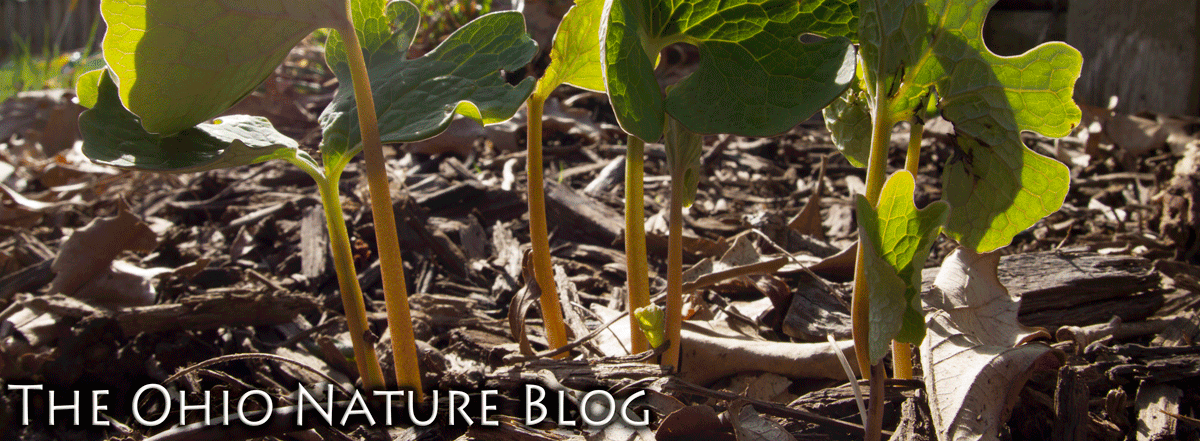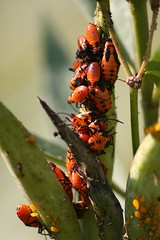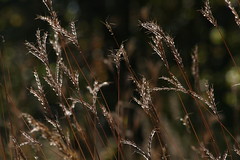When Megan and I chose to live where we live, I was excited. We were going to be renting a house. I hadn't lived in a house year-round since I left my parent's place in 1997. Megan was an apartment dweller during that period as well. Well, mowing the lawn and tending to the weeds got old fast. I thought I'd be into the gardening, mowing the grass, and I thought I would wash my car every week in our driveway. None of that really has come to fruition! What has drawn my attention? Credit the Olentangy River and the green corridor that is a stone's throw from our house. Last fall I only discovered just a small little bit of what the river and linear forest bisecting our great city had to offer. In 2007, I've taken full advantage, trying to uncover every rock, photograph each organism, and for that matter, practically every inch of space. So it has been fun. Yes, we live in a hole, some of the houses up the street are a bit iffy, but it has been fun.
Thursday evening and Friday afternoon I took full advantage of the goodness that surrounds our house. We had quite a bit of rain this past week, and the Olentangy was swollen. Couple that with a decent sunset, and there were several photographic opportunities to be had.


In the photo below, I set the camera on my tripod, set a very small aperture and very long shutter speed, say about five seconds, to create the blurring effect seen here as the cottonwoods swayed in the stiff evening breeze.

Although we had a clearing Thursday night at sunset, clouds moved in for Friday and I had to look hard for decent photos Friday afternoon. Its too bad I don't have faster lenses, that let more light into the camera. I have to compensate by using a high ISO setting which leaves the resulting image fairly grainy, but it allows me to record what I'm seeing. Alternatively, I can use a tripod. This male cardinal was hanging out amongst some dried grape vines. These birds love scrubby habitat, and are ridiculously abundant around our house.

We also have bird predators, like this cooper's hawk. My neighbor calls it a falcon. I've mistaken them for peregrine falcons before as well. But most likely, if you see a small hawk in a neighborhood, its a cooper's, and it is looking for birds near feeders. This one alighted on top of the black walnut tree. The house sparrows spotted the bird, and everything went silent. I tried to find an angle where I could get a nice profile shot, was unsuccessful, but before the bird swept out of view, I fired off a few rounds of the camera and came up with this shot.

Saddened that I couldn't get better shots of the cooper's hawk, I headed towards the park and to the river. The floodplain was wet, and I wore my calf-high boots. Areas like this are flooded by runoff from the parking lot at Graceland shopping center. It looks like it might harbor amphibians and other vernal pool dwelling creatures, but this one is fairly void of aquatic life. It does have some nice mature ash trees and box elder.

Along this stretch of the river, the colors are mostly light oranges and yellows. The closest to red we get is from the very few sugar maples on the opposite bank of the Olentangy.

I dropped down a bit to the floodway, checking out one of my favorite areas of the park. This channel is typically dry during the summer, but fills quickly when we have heavy rains.

White mulberry trees, no higher than fifteen feet, gave the park splashes of yellow. This tree,
Morus alba, is, unfortunately, not native.

Sycamores and red maples are fairly amazing trees. They can take the inundation of the floodwaters with regularity. Their roots can become exposed, creating quite a trip hazard. They remind me of snakes. I'm always on the lookout for a nice black rat snake, which surely would have inhabited this strech of the river at one time, but I haven't seen any, and I'm guessing that the area has too many people, too many predators, and too much disturbance to harbor Ohio's largest snake.

For those from Minnesota, our Ohio poison ivy grows on trees. It also can put on nice show in the fall, with its leaves turning yellow, or sometimes even red. Speaking of poison ivy, I don't know how many people have told me that they were cutting up a tree and got poison oak right from the tree. Thats right. Poison oak. There is NO PLANT in Ohio named POISON OAK! NONE! (Don't believe me? visit the
USDA site for a range map. We have poison Ivy and Poison Sumac, and the latter only grows in bogs, fens, and swamps.

As I was walking around the floodplain, I found this rather interesting rock. At first I thought it was some gang tag graffiti, but I quickly realized that I had just desecrated the burial site of the best hamster ever, the famous "Chocolaut." Welcome to the city.

That kinda left me shaking my head. Why not bury your hamster in your own back yard? Anyways, I was getting tired and thirsty-- it was time to head home. On my way back, I picked up this white throated sparrow. Good to see these are back for the winter. I have missed them and their old Sam Peadody whistle they make.

And finally, I was watching this cardinal in some invasive Amur honeysuckle, and sure enough, this darn thing ate one of the berries. I really hadn't seen this before. Everything I have read about honeysuckle berries points out how they are a low quality food source for birds. Full of sugar and low in lipids. Perhaps this cardinal has developed a bit of a sweet beak???

Tom





















































